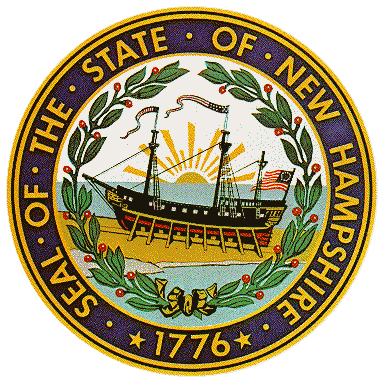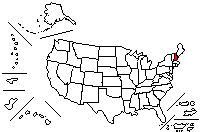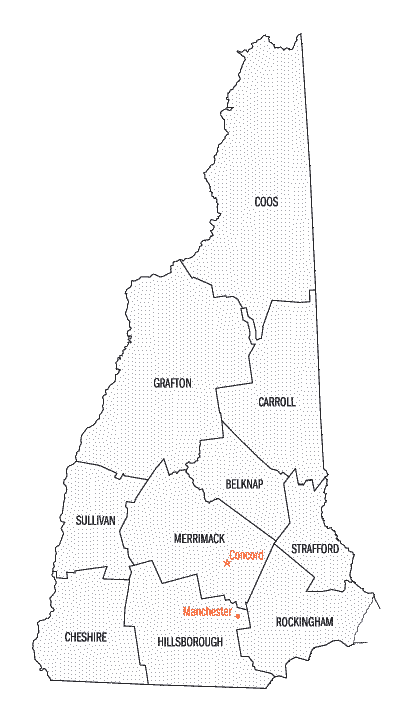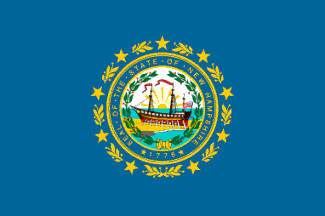
 |
|

















Old New Hampshire |
Viejo Nueva Hampshire escrito por Dr. John F. Holmes Compuesto por Maurice Hoffmann Con una habilidad de desconocida medida, del dorado almacén del destino Dios, en su gran amor y sabiduría, hizo el escarpado estado del granito; Hizo los lagos, los campos, los bosques; Hizo los ríos y los arroyuelos; Hizo burbujear, fuentes cristalinas de las Colinas de Granito. Viejo Nueva Hampshire, Viejo Nueva Hampshire, Viejo Nueva Hampshire magnífico y grandioso cantaremos del Viejo Nueva Hampshire, del amado viejo Estado de Granito. Construyó, él, la gloriosa Nueva Hampshire desde las fronteras al mar; Y con encanto y esplendor incomparables la bendijo para la eternidad. Aquí, la majestuosidad de la montaña; Aquí, la grandiosidad del lago; Aquí, la exactitud como desde la ladera de donde sus cristalinas aguas rompen. Viejo Nueva Hampshire, Viejo Nueva Hampshire, Viejo Nueva Hampshire magnífico y grandioso cantaremos del Viejo Nueva Hampshire, del amado viejo Estado de Granito. |


Flag:
New Hampshire did not officially adopt a state flag until 1909. Prior to that, New
Hampshire had numerous regimental flags to represent the state. The flag has only been
changed once, in 1931 when the state's seal was modified.
The body of the flag is blue. The center of the flag has the state's seal
with the frigate Raleigh -- all surrounded by laurel leaves and nine stars.
The state flag shall be of the following color and design: The body or field shall
be blue and shall bear upon its center in suitable proportion and colors a representation
of the state seal. The seal shall be surrounded by a wreath of laurel leaves with nine
stars interspersed. When used for military purposes the flag shall conform to the
regulations of the United States.
Bandera:
Nueva Hampshire no adoptó oficialmente una bandera del estado hasta
1909. Antes de esto, Nueva Hampshire tenía numerosas banderas
de regimientos
para representar el estado. La bandera ha sido cambiado
solo una vez, en 1931 en que el sello del estado fue modificado.
El cuerpo de la bandera es azul. El centro de la bandera tiene el
sello del estado con la fragata Raleigh -- rodeado todo por laureles
y nueve estrellas.
La bandera del estado es de la siguiente forma: El
cuerpo o el campo será azul y llevará sobre su centro en la
proporción conveniente y coloreada una representación del sello del
estado. El sello estará rodeado por una guirnalda de laureles
con
nueve estrellas. Cuando sea utilizada para
propósitos militares la bandera se conformará con las regulaciones
de los Estados Unidos.

New Hampshire
New Hampshire (niú-jámp-shair en inglés y español) Nueva Hampshire.
Capital City: Concord
National: New Hampshirites
Admission to Statehood: June 21, 1788
Border States: Maine - Massachusetts - Vermont
Motto: Live Free or Die
These words were written as a toast for a veterans’ re
union on July 31, 1809, by General John Stark. The motto was adopted by the
legislature in 1945.
Origin of the name: Nameb by England based by the county of Hampshire in England.
Nickname: Granite State
Ciudad Capital: Concord (se pronuncia cón-cord en inglés y español)
Gentilicio: Novo Hampsherinos (jámp-sherinos)
Estados Limítrofes: Maine - Massachusetts - Vermont
Lema: Vivir libre o morir
Estas palabras fueron escritas como un saludo a los veteranos
de la unión el 31 de julio de 1809, por el General John Stark. Este lema fue adoptado por la
legislatura estatal en el 1945.
Origen del nombre: Nombre dado por Inglaterra por el condado de Hampshire de Inglaterra.
Cognómento: El Estado de Granito.


The Seal:
New Hampshire has had a state seal for more than 200 years, but its present form is
only 50 years old.
The seal was first created in 1775 by the First Provincial Congress.
It comprised a pine tree and an upright fish, on each side of a bundle of five arrows.
The design reflected the state's then two major economic resources,
and the arrows symbolized the strength of unity among the then five counties.
When the present state constitution became effective in 1784,
the new Legislature revised the seal, to depict a ship on stocks,
with a rising sun in the background, to reflect Portsmouth having become a major
shipbuilding center during the war years. Various items for shipment were also shown
on a frontal dock.
Details of this 1784 seal became so distorted in the ensuing century and a half that
the 1931 Legislature voted major improvements, and, or the first time,
spelled out its makeup. Director Otis G. Hammond of the New Hampshire Historical
Society sparked this adjustment, by reporting that artists and sketchers had injected
surprising details into the seal, as they produced new dies every few years
for official state use. They produced rum barrels on the dock, and, on occasion,
even human beings beside them.
When Governor John G. Winant of Concord launched a second term in 1931,
he named a committee to serve with Hammond, to produce a less objectionable seal.
The 1931 Legislature readily approved its recommendations.
Historic Warship Honored. The frigate Raleigh, built at Portsmouth in 1776, as one of the first
13 warships sponsored by the Continental Congress for a new American navy,
became the centerpiece of the 1931 seal. The figure 1784 on the old seal was changed to 1776.
The old Latin phrase "Neo Hantoniensis 1784 Sigillum Republica" around the circular
seal was replaced with "Seal of the state of New Hampshire 1776." The 1931 seal
law spelled out that only a granite boulder could be shown in the foreground,
as symbolic of the Granite State's rugged terrain and the character of its citizenry.
The Raleigh has a checkered career of adversities, while becoming the first to carry
the American flag into sea battle. She was unable to go to sea for 15 months for lack of
armament, and after her first voyage to France for munitions,
her captain was dismissed for incompetency. Soon thereafter she was beached off Maine,
captured by British warships, and used for the remainder of the Revolutionary War
against her own country.
Captain John F. Rowe (USN retired) of Newington resurrected the life and
lore of the Raleigh in recent years. The British liked the sturdiness of the
frigate so much that they sketched its construction details, to build others like it,
and Captain Rowe obtained the drawings from London, to enable him to paint
the Raleigh in all its pristine glory. And when Governor Hugh J.
Gallen and his Executive Council celebrated the 300th anniversary of
New Hampshire's state government, Publisher William Loeb of the Union Leader
and New Hampshire Sunday News purchased an enlarged portrait of the Raleigh,
by Captain Rowe, and presented it to the state for permanent display in the State House.
Nueva Hampsire ha tenido un sello por más de 200 años, pero la forma actual solo tiene 50 años.
El sello fue creado en el 1775 por el primer Congreso Provinsial y este comprendía de un árbol de
pino y un pez en forma vertical dirigido hacia la derecha y en cada lado un grupo de 5 flechas.
El diseño reflejaba las 2 fuentes económicas del estado para ese entonces y las flechas
simbolizaban la fuerte unidad entre los 5 condados.
Cuando la constitución del estado actual llegó a ser eficaz en 1784,
la nueva legislatura revisó el sello, para representar una nave en
acción, con un sol naciente en el fondo, para representar a
Portsmouth que era un centro importante de la construcción naval
durante los años de guerra. Los varios artículos de embarque,
también, fueron presentado en un muelle frontal.
Los detalles de este sello 1784 fueron tan distorcionados durante
el próximo siglo y medio que la legislatura del 1931 votó para hacerle
mejoras importantes y por primera vez explicar su significado.
El
Director Otis G. Hammond de la Sociedad Histórica de Nueva Hampshire
provocó este ajuste, alegando que los artistas y los bosquejos
habían añadido sorprendentes detalles en el sello, pues
produjeron nuevas cuñas pocos años para el uso oficial del
estado. Añadieron barriles de ron en el muelle, y en ocaciones,
personas al lado de ellos.
Cuando el gobernador John G. Winant de Concord lanzó un segundo
término en 1931, él nombró a un comité Hammond,
producir un sello menos objetable. La legislatura 1931 aprobó
fácilmente sus recomendaciones.
El honroso buque de guerra, La fragata Raleigh, construido en
Portsmouth en 1776, como uno de los primeros
13 buques de guerra patrocinados por el congreso continental para una
nueva marina americana, se convirtió en la pieza central del sello
1931. La fecha 1784 del viejo sello fue cambiado a 1776. La vieja
frase latina " Hantoniensis neo Sigillum 1784 Republica " alrededor
del sello fue substituida por el " sello del estado de
Nueva Hampshire 1776." El sello 1931 que la ley hizo que
solamente un pedazo granito se podría mostrar en el
primero plano, como simbolo del terreno escarpado del estado del
granito y del carácter de sus ciudadanos. El Raleigh tiene una historia de
altibajos y adversidades, mientras que se convierte en el
primero en llevar la
bandera americana en batalla naval. No podía estar en el mar por 15
meses por la carencia de armamento, y después de su primer viaje a
Francia por municiones, despidieron a su capitán por
incompetente. Pronto quedó varada a las afueras de Maine,
y fue capturada por los buques
de guerra británicas, y utilizada durante el
resto de
la guerra revolucionaria contra su propio país.
Capitán John F. Rowe (USN jubilado) de Newington resucitó la vida y
la gloria del Raleigh en años recientes. Los Británicos tuvieron
gusto de la robusteza de la fragata tanto que bosquejaron sus detalles
de la construcción, para construir otros como ella, y capitán Rowe
obtuvo los dibujos de Londres, para permitirle pintar el Raleigh en
toda su gloria. Y cuando gobernador Hugh J. Gallen y su
consejo ejecutivo celebraron el 300o aniversario del gobierno del
estado de Nueva Hampshire, el editor William Loeb líder de la
unión y "New Hampshire Sunday News" compraron un retrato
agrandado del Raleigh, por capitán Rowe, y lo presentado al estado
para la exhibición permanente en la casa del estado.
The seal of the state shall be 2 inches in diameter, circular, with the following detail
and no other: A field crossed by a straight horizon line of the sea, above the
center of the field; concentric with the field the rising sun, exposed above
the horizon about 1/3 of its diameter; the field encompassed with laurel; across
the field for the full width within the laurel a broadside view of the frigate Raleigh,
on the stocks; the ship's bow dexter and higher than the stern; the 3 lower masts shown
in place, together with the fore, main and mizzen tops, shrouds and mainstays; an ensign
staff at the stern flies the United States flag authorized by act of Congress June 14,
1777; a jury staff on the mainmast and another on the foremast each flies a penant; flags
and pennants are streaming to the dexter side; the hull is shown without a rudder; below
the ship the field is divided into land and water by a double diagonal line whose highest
point is sinister; no detail is shown anywhere on the water, nor any on the land between
the water and the stocks except a granite boulder on the dexter side; encircling the field
is the inscription, SEAL OF THE STATE OF NEW HAMPSHIRE, the words separated by round periods,
except between the parts of New Hampshire; at the lowest point of the inscription is the date
1776, flanked on either side by a 5-pointed star, which group separates the beginning and end
of the inscription.
Es sello del estado deberá ser de 2 pulgadas de diametro, circular, con los siguientes detalle
y no otros: Un fondo cruzado por una linea recta del horizonte del mar, en el mismo centro de
ese fondo aparecerá un sol naciente expuesto en el horisonte a un tercio de su diámetro rodeado
con ramas de laureles y dentro aparecerá la fragata Raleigh, la proa estará más alta que la
popa, tendrá tres mástiles en el que el mástil delantero y el principal tendrán unos banderines.
En la popa aparecerá la bandera de los Estados Unidos autorizado por el Congreso del 4 de junio
de 1777. Los banderines y la bandera fluyen a dirección de la proa, la nave se muestra sin un
timón. Bajo el barco el fondo estará dividido entre mar y tierra por una doble línea diagonal
cuyo punto más alto está a la izquierda. No aparece detalles de agua ni tierra a excepción de
un borde de granito en el frente. Al rededor del sello aparece la inscripción: Sello del Estado
de Nueva Hampshire separados por puntos en el medio con excepción entre las palabras Nueva Hampshire.
En la parte de abajo aparece la fecha 1776 entre dos estrellas de cinco puntas una al principio
y otra al final.

History
New Hampshire lies between Maine on the east and Vermont on
the west in northern New England. Its southern boundary, except
for the southeast corner that provides its 29 km (18 mi) of
Atlantic coastline, borders Massachusetts. New Hampshire's
northern tip touches the Canadian province of Quebec.
Of New Hampshire's 24,043 sq./km. (9,283 sq./mi. ),
about 85% is covered with woods. The state derives its
name from the county of Hampshire, England, where Capt.
John Mason, the founder and first proprietor of the colony,
was governor of the English city of Portsmouth, for which
New Hampshire's only port city is named.
English fishing and trading settlements began (1623)
at Odiorne's Point--near the mouth of the Piscataqua--and
a few years later at nearby Hilton's Point (now Dover).
In 1629 the original proprietors of the whole area between
the Merrimack and Kennebec rivers, Sir Ferdinando Gorges and
Captain John Mason, divided the area between them,
Mason taking the area south of the Piscataqua, which
he called New Hampshire. From 1641 to 1679, and again from
1690 to 1692, the New Hampshire settlements came under the
jurisdiction of Massachusetts, and from 1699 to 1741,
New Hampshire shared a royal governor with Massachusetts.
The decisive change in the importance and prospective fortunes of the
province came in 1741 with the settlement of the long-disputed
boundary with Massachusetts in New Hampshire's favor and the
appointment of Benning Wentworth as governor. A dispute with New
York over the area west of the Connecticut River, the so-called
New Hampshire Grants (present-day Vermont), was temporarily
resolved in 1764. Benning Wentworth was succeeded (1767) by
his nephew, John Wentworth. The latter's administration began
auspiciously with a series of successful moves to bind Portsmouth
and the seacoast more closely to the developing interior, but the
Revolutionary crisis proved to be a stronger force than was the young
governor's popularity. In the first overtly hostile act of the
American Revolution an armed mob stormed the fort in Portsmouth
Harbor in December 1774, seized arms and powder, and distributed
them among several inland towns, some of whose militiamen later
used them in the Battle of Bunker Hill. Wentworth left the province
on a British warship in June 1775. The next year New Hampshire
adopted its own constitution and was, thus, the first colony to
become wholly independent of Great Britain. In 1788, New Hampshire
became the ninth state to ratify the U.S. Constitution.
Nueva Hampshire se encuentra entre el estado de Maine al este y
el estado de Vermont en el oeste en
Nueva Inglaterra norteña. Su límite meridional, a excepción de la
esquina suroriental que proporciona sus 29 kilómetros (18 millas) de
la línea de la costa atlántica, confina Massachusetts. La nueva
extremidad norteña de Hampshire toca la provincia canadiense de
Quebec. De 24.043 sq./km nuevos de Hampshire. (9.283 sq./mi.), sobre
85% se cubre con maderas. El estado deriva su nombre del condado de
Hampshire, Inglaterra, en donde Capt. John Mason, el fundador
y el primer propietario de la colonia, eran gobernador de la ciudad
inglesa de Portsmouth, por la cual se nombra la única ciudad
portuaria de Nueva Hampshire.
La pesca inglesa y los establecimientos de intercambios comenzaron
(1623) en el "Odiorne's Point" -- cerca de la desembocadura
del Piscataqua -- y
algunos años más tarde en Hilton's Point (ahora Dover).
En 1629 los propietarios originales del área entre los ríos
Merrimack y Kennebec, Sir Ferdinando Gorges y el capitán
John Mason, dividieron el área entre ellos, Mason tomaba el sur
del área del Piscataqua, que él llamó Nuevo Hampshire. A partir el
1641 a 1679, y otra vez a partir el 1690 a 1692, los establecimientos
de Nueva Hampshire estubieron bajo jurisdicción de Massachusetts, y a
partir el 1699 a 1741, Nuevo Hampshire compartieron un gobernador real
con Massachusetts.
El cambio decisivo en importancia y las fortunas anticipadas de la
provincia vino en 1741 con el establecimiento del límite
largamente disputado con Massachusetts en el favor de Nueva Hampshire
y la
designación de Benning Wentworth como gobernador. Un conflicto con Nueva York
sobre el área al oeste del río de Connecticut, el tan llamado Concesión de Nueva Hampshire
(actual estado de Vertmont), fue resuelto temporalmente en
1764. Benning Wentworth fue substituido (1767) por su sobrino, John
Wentworth. La última administración comenzó propiciamente con una
serie de movimientos acertados de atar Portsmouth y la costa al mar más de
cerca al desarrollo interior, pero la crisis revolucionaria
demostró ser una fuerza más poderosa que la popularidad del joven gobernador.
En el primer acto abiertamente hostil de la revolución
americana una multitud armada tomó por asalto la fortaleza en el puerto de
Portsmouth en diciembre de 1774, consiguiendo armas y pólvora, y los
distribuyó entre varias ciudades interiores, alguno de que milicianos
lo utilizaron más adelante en la batalla de "Bunker Hill".
Wentworth dejó la provincia en un buque de guerra británico en junio
de de 1775. Al año siguiente Nueva Hampshire adoptó su propia
constitución y convirtió en la primera colonia en llegar a ser
enteramente independiente de gran Gran Bretaña. En 1788, Nueva Hampshire
se convirtió en el noveno estado al ratificar la
constitución de ESTADOS UNIDOS.
Historia
